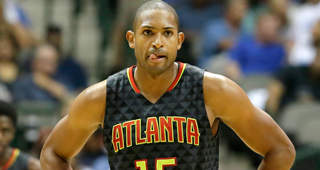Much has been made about the Celtics efforts to acquire two stars this summer to add to their young core. While Kevin Durant didn’t choose Boston, Al Horford did and he should make a major impact on the Celtics this coming season. He’s already the best big on the roster by far and his fit on both ends of the floor should vastly upgrade the Boston interior.
The Boston big rotation last year featured a diverse mix with holdovers Amir Johnson, Jonas Jerebko and Kelly Olynyk. All bring something different to the table, but none are quite as diverse in their games as Al Horford. For example, the best post-up player and defender of that bunch is Johnson by a comfortable margin. Olynyk is the best shooter. Jerebko is the most versatile. And if Tyler Zeller returns, he excels at running the floor for early offense.
Jared Sullinger, who left Boston for Toronto, was the best rebounder the team had last year. All of those players have specific skills, but none possess the all-around game Horford does on both ends of the floor.
After years of gradually extending his range, Horford became a real threat from behind the arc. He made 88 threes and shot 34.4%. As Horford hits age 30 this year, adding a long-range shot is key to his production. He was once a mid-range master, but mid-range shots often require moves or shooting off the dribble. This is much harder for an older player to get by with. By adding the three to his repertoire, in addition to his continued solid inside game, Horford becomes harder to defend. He’ll play plenty of minutes at center and, despite the continued downsizing of the NBA, most centers still aren’t comfortable defending on the perimeter. This gives Horford an advantage most nights on the offensive end of the floor.
As to how he might pair with the other bigs on the Boston roster, Horford’s diverse game should complement Johnson, Olynyk and Jerebko nicely. When paired with Johnson, Horford will likely be used in the pick and roll and pick and pop game. The Celtics also won’t hesitate to put him in the mid-post area and let him iso occasionally, especially if he’s defended by a traditional center. If opposing teams match him with a power forward, he’ll set up shop inside. Horford and Johnson are also good enough passers that both can move the ball to teammates for solid looks.
When paired with Olynyk, he’ll likely be more of an inside presence. Olynyk prefers to drift around the perimeter for jumpers or dive to the basket from the weak-side off penetration. Olynyk’s shooting ability should help draw the second big from the paint and free things up inside for Horford. It wouldn’t be surprising to see this pairing contribute to some of Boston’s more successful offensive lineups this coming season.
In lineups next to Jerebko, the Celtics will be at their most versatile. Both Horford and Jerebko are comfortable from any point on the floor. Both are skilled ball movers who snap passes and run to the next position on the floor. Horford’s patient, measured approach will mesh well with Jerebko’s hectic style of all-out hustle. Being able to shoot and score from anywhere will give the Celtics options they haven’t had the previous few years.
Horford and Zeller won’t likely share the floor very often, as neither is a fit to defend power forwards for any sustained period of play. If they do, it will likely look similar to the pairing with Johnson, with Horford playing outside. Horford’s ability to pass the ball could help Zeller get easy looks, as Zeller is rarely able to create offense of his own and relies on his teammates to get him baskets.
On the defensive end of the floor, Boston now has a legitimate shot blocking threat, which they’ve lacked for years. Amir Johnson led the Celtics in blocks last year with just over one per game. While Horford had the identical block rate as Johnson last season at 3.6 percent, the extra length and challenges at the basket is a welcome addition to a team that struggles with rim protection. While Boston’s interior defense isn’t necessarily bad, it is greatly aided by some of the best perimeter defenders in the NBA in Avery Bradley, Marcus Smart and Jae Crowder. With a solid rim protector behind them, the Celtics’ perimeter defense could be even better this season, as they’ll be allowed to pressure ball handlers even more than previous years, resulting in more turnovers and bad shots.
As far as defensive matchups go, Horford is likely to play most of his minutes matched against the opposing center. He’s expressed a desire to play more minutes at the 4, but the general feeling is that is more on offense than defense. When paired with Johnson, their similar defensive skill sets should allow the Celtics to switch more often. Last year’s lineup of Johnson and Sullinger left Johnson to defend the quicker of the two opposing big men most nights. Boston also couldn’t employ switching as often, as Sullinger wasn’t able to move his feet well enough to take on quicker bigs. The switching tactic is something most teams prefer to build into their defensive coverages, as it allows for the most adaptable defense. The Celtics should also be able to switch with Olynyk and Jerebko as well considering both are quick enough to cover any opposing big and have just enough bulk to defend the stronger players.
Being that a defensive possession doesn’t end until you secure the ball off a turnover or rebound, the Celtics should be okay in this department. While never regarded as a top flight rebounder, Horford should be at least equal to Sullinger in that area. And because of his ability to help and recover on pick and roll/pick and pop, the rest of the defense shouldn’t be scrambling as much. This should allow the Celtics to focus on getting a body on a body and hit the boards effectively as a unit.
Overall, to this point, the Celtics have essentially replaced Sullinger with Horford and Evan Turner with rookie Jaylen Brown. In both cases, Boston has upgraded their athleticism and versatility. Too much can’t be expected out of Brown as he replaces the criminally underrated Turner. But expectations will be and should be high for Horford replacing Sullinger. Not only is Horford arguably the first major free agent the Celtics have ever added, but his addition is the first step in getting out of the first round of the Eastern Conference playoffs. That comes with enormous pressure, but with Brad Stevens making the best use of his versatile new weapon on both ends, Al Horford should be more than able to meet the challenge.



